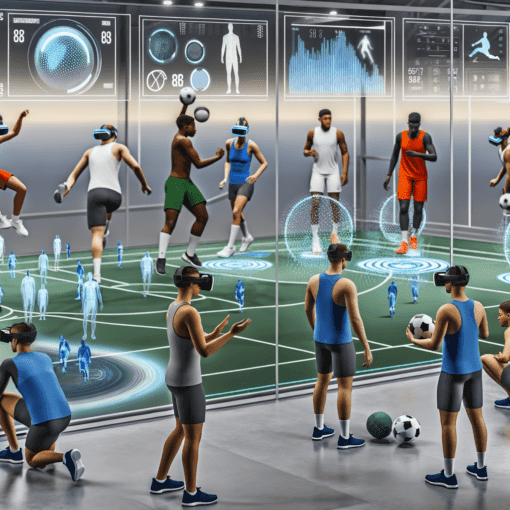Introduction
Virtual Reality (VR) is no longer a futuristic concept reserved for gaming enthusiasts and tech aficionados. It’s become a revolutionary tool shaping various industries, with VR sports training games standing out as a particularly intriguing application. This innovation marries immersive technology with athletic training, offering athletes unparalleled opportunities to enhance their skills, analyze performance, and train in environments that were previously unimaginable. The convergence of VR technology with sports training is not only pushing the boundaries of athletic performance but also opening new avenues for startups eager to make their mark as disruptors.
The Innovation Potential of VR Sports Training Games
Innovation in VR sports training games is not merely about creating novel experiences; it’s about substantially improving training efficacy and athlete performance. The potential here stems from VR’s ability to simulate realistic and controlled environments. This capability allows athletes to engage in rigorous training routines without the physical wear and tear associated with traditional methods. For instance, VR can replicate high-stakes game situations with precise data simulations, enabling athletes to practice decision-making, reaction times, and strategies from the comfort of their homes or training facilities.
Dissecting Market Disruption and Consumer Adoption
The integration of VR in sports training disrupts traditional training methodologies—redefining how athletes interact with their training environment. Key to this disruption is the ability to provide an immersive experience that traditional training tools cannot match. Adoption rates have been influenced by the rapid decline in VR hardware costs and the increasing recognition of its potential by major sports leagues and trainers. However, there’s a nuanced challenge of bridging the gap between interest and sustained use, a conundrum many startups face as they seek to foster continuous engagement and value perception among their users.
Key Challenges in the VR Sports Training Ecosystem
Despite its potential, VR sports training games face several challenges. Technical issues like motion sickness, hardware limitations, and the need for realistic haptic feedback can hinder user experience. Moreover, there’s a significant barrier in creating content that is both engaging and educational, balancing entertainment with practicality. Startups also contend with the difficulty of integrating VR systems with existing training methodologies and gaining acceptance from traditional sports training authorities wary of adopting new technology. Overcoming these barriers is crucial for startups aiming to establish VR sports training as a mainstay in athletic development.
Unique Opportunities for Startups in VR Sports Training
The landscape is ripe with opportunities for startups willing to innovate and push the boundaries. One unique prospect lies in the development of personalized training programs leveraging AI and machine learning to analyze an athlete’s performance and tailor feedback accordingly. Another trailblazing avenue is the creation of multiplayer platforms that enable athletes to train together in virtual environments, fostering competitive spirit and collaboration without geographical limitations.
Strategies for Fundraising and Scaling
The path from startup to successful enterprise in the VR sports training sector often begins with securing funding. Venture capitalists are particularly interested in technology that displays potential for scalability and market penetration. Startups need to craft compelling stories that not only highlight their technological prowess but also demonstrate clear value propositions and potential ROI for investors. Successful case studies, such as STRIVR Labs—who transitioned from a scrappy team to becoming a leading player by providing VR training tools to elite sports teams—highlight the importance of strategic partnerships and clear demonstrations of product effectiveness.
Scaling requires a dual focus on market penetration and technological evolution. Startups must ensure their products remain innovative and ahead of competitors by continuously seeking improvements through user feedback and technological advancements. Entering new markets can be strategically executed by leveraging partnerships with schools, amateur sports leagues, or international teams.
Achieving Product-Market Fit
Achieving product-market fit is a fundamental step for any startup, and VR sports training games are no different. This journey entails thorough market research to understand the specific needs and pain points of athletes and coaches. Iterative testing and constant feedback loops are essential in refining VR products to ensure they meet the expectations of their users. Successful startups often maintain a strong emphasis on user engagement and versatility—factors that ensure their products do not become obsolete or underused.
Customer Acquisition Strategies
For startups in this sector, acquiring customers involves more than just marketing a product—it’s about building relationships and cultivating trust. Demonstrations and trials are critical as VR is a particularly experiential technology. Hosting workshops and collaborating with sports institutions for pilot projects can serve as effective entry points. Moreover, fostering a community around their product, such as through forums or exclusive training sessions, can enhance brand loyalty and word-of-mouth referrals.
Distinctive Aspects and Business Models in VR Sport Training Startups
Innovative business models are a hallmark of successful VR startups. Subscription-based models, allowing for regular software updates and new content, align well with ongoing training needs and technological advancements. Another promising approach is leveraging a Software-as-a-Service (SaaS) model, providing scalable software solutions in tandem with minimalistic, large-scale VR training setups across multiple sports facilities.
Conclusion
VR sports training games represent a transformative force within the realm of athletic training, promising to elevate athlete performance and redefine training paradigms. The opportunity for startups lies not only in creating advanced technology but in strategically navigating the market through robust business models, effective customer acquisition strategies, and an unwavering commitment to product-market fit. By overcoming technical and adoption challenges and tapping into the unique advantages of VR, startups in this space can leverage their technology to disrupt the industry, unlocking new potential for both seasoned athletes and aspiring stars. As the landscape evolves, the startups that combine innovation with strategic acumen are poised to lead the charge into a new era of sports training.

